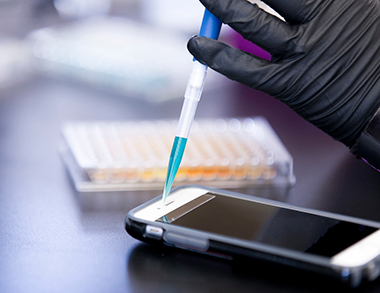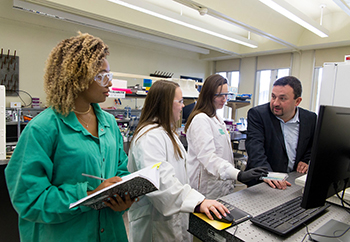Chemist Proposes 'Sweat Analysis' to Better Secure Electronics
 |
|
Chemist Jan Halámek is proposing a biometric-based approach to better secure electronic devices. (Photo by Carlo de Jesus) |
ALBANY, N.Y. — Jan Halámek believes there is a better method to securing electronic devices – and it relies on our own sweat.
Biometric Authentication:
Halámek, an assistant professor of chemistry at the University at Albany, has released a concept paper in ChemPhysChem that proposes a new biometric-based authentication approach for unlocking mobile and wearable devices, such as smart phones and smart watches.
The approach relies on analyzing skin secretions – or sweat – to build an amino acid profile that is unique to the device owner. The profile would be stored within the device and used for identification purposes each time an attempt to unlock is made.
“We are developing a new form of security that could completely change the authentication process for electronic devices,” Halámek said. “Using sweat as an identifier cannot be easily mimicked or hacked by potential intruders. It’s close to full-proof.”
Skin secretions contain a large number of metabolites that can be targeted for authentication analysis.
To build a profile, the device would first have a “monitoring period” in which it would continuously measure its owner’s sweat levels at various times of the day. For example, those who work overnight shifts would have a vastly different profile at 2 a.m. than those who work day shifts. Other factors, including age, biological sex, race and physiological state of the individual would also play a role.
Once the profile is developed, the owner would be identified once holding the device/wearing it.
The approach would not only improve on current authentication methods, but also help people with certain disabilities, who may be unable to move their fingers in a specific position to open the device or have a caretaker who is unlocking the device without permission. The device owner would also not have to remember a passcode.
 |
|
Halámek (far right) conducts research with students in his lab. (Photo by Carlo de Jesus)
|
“The current forms of authentication have proven to be less than ideal,” Halámek said. “Passwords and pins can easily be seen over someone’s shoulder and there are many internet tutorials on how to create a fingerprint mold that is capable of opening a device. There’s also issues with facial recognition, which often times does not work correctly.”
Halámek has tested the analysis in his lab with success. The next step is to collaborate with an engineer who can help with implementation.
His co-authors on the paper are Vladimir Privman, a professor at Clarkson University, and UAlbany graduate student Juliana Agudelo.
Catching Criminals:
Halámek’s new concept paper is his first that focuses on cybersecurity, but adds to a growing portfolio of research that involves testing biomarkers to catch criminals.
Over the last two years, Halámek and his research team have been featured in dozens of media outlets across the globe for their forensic discoveries. Some of the largest publications include the New York Times, National Geographic, Scientific American and Chemical and Engineering News.
By testing compounds within physical evidence left behind at a crime scene– like fingerprints or blood residue – Halámek and his team can identify key characteristics of culprits within minutes and without DNA testing. This includes their age range, sex and ethnicity.
“It’s all about the biomarkers when you’re looking for the attributes of a person,” said Halámek. “It’s pure chemistry.”
Halámek’s forensic research is ongoing through numerous collaborations on campus and with researchers from other universities around the nation. His lab was also recently awarded with a three-year grant through the Department of Justice and National Institute of Justice to continue developing their fingerprint analysis.
You can learn more about Halámek by visiting his research website and expert page.
![]() For more news, subscribe to UAlbany's RSS headline feeds
For more news, subscribe to UAlbany's RSS headline feeds
A comprehensive public research university, the University at Albany-SUNY offers more than 120 undergraduate majors and minors and 125 master's, doctoral and graduate certificate programs. UAlbany is a leader among all New York State colleges and universities in such diverse fields as atmospheric and environmental sciences, business, education, public health,health sciences, criminal justice, emergency preparedness, engineering and applied sciences, informatics, public administration, social welfare and sociology, taught by an extensive roster of faculty experts. It also offers expanded academic and research opportunities for students through an affiliation with Albany Law School. With a curriculum enhanced by 600 study-abroad opportunities, UAlbany launches great careers.


